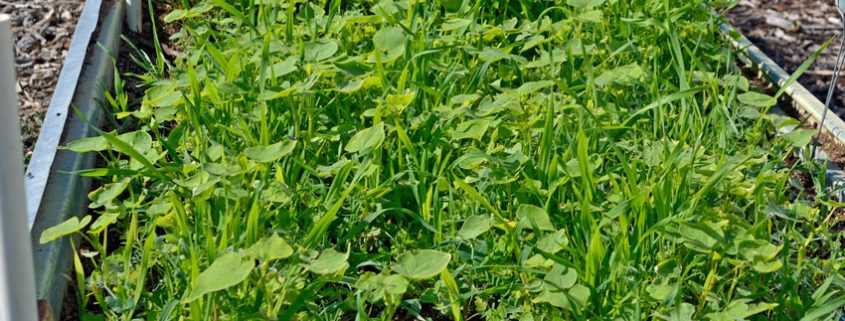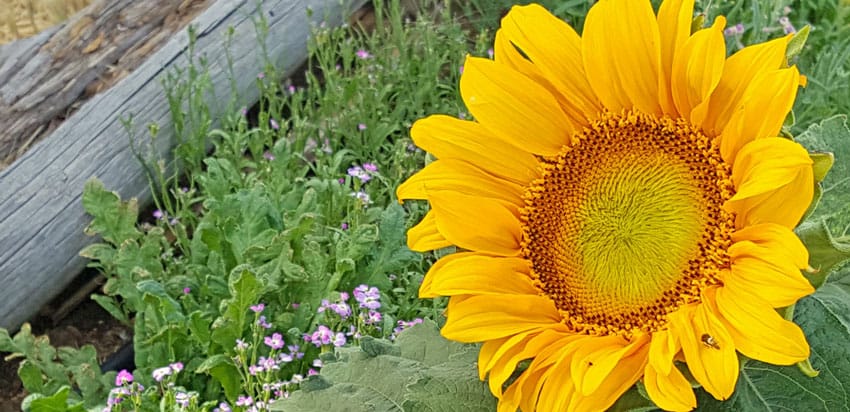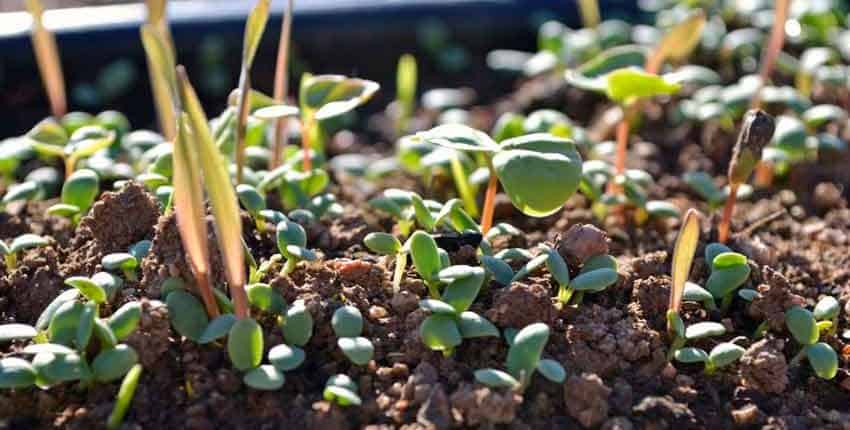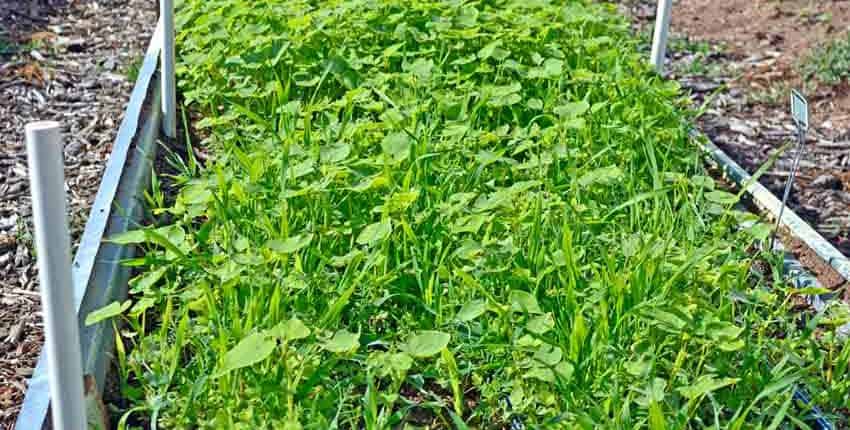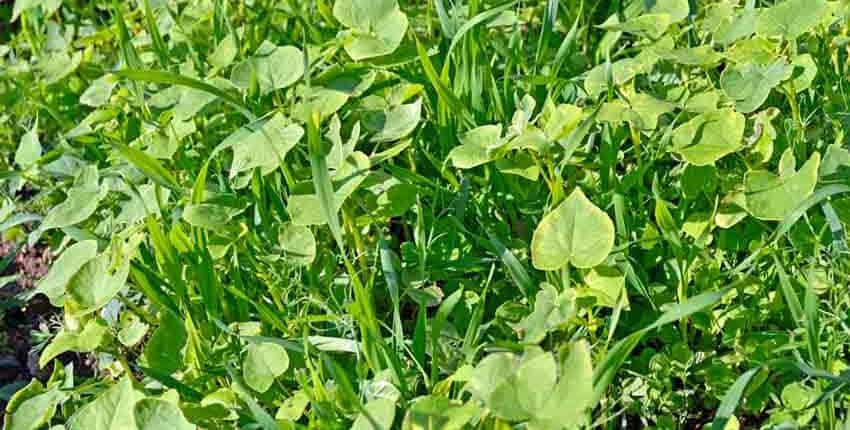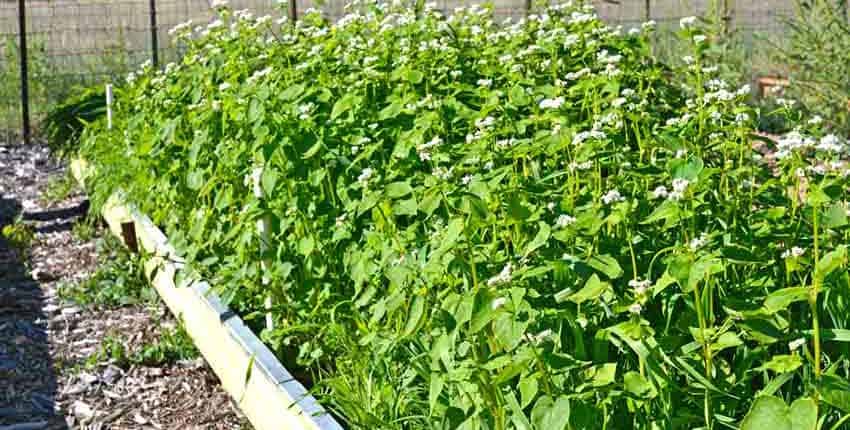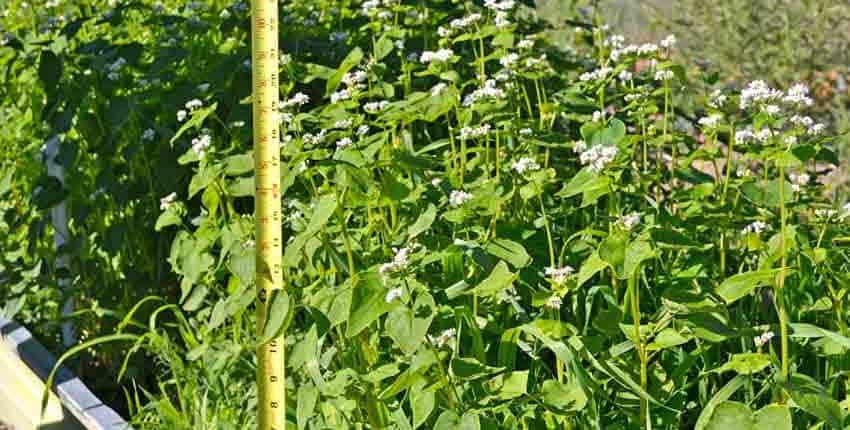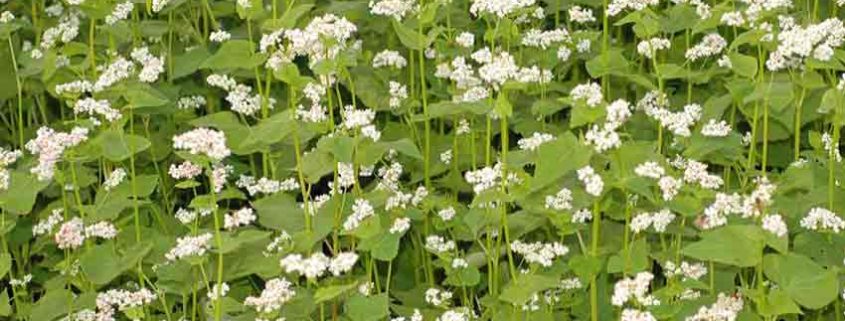Discover the power of cover crops for easy soil improvement in your garden. Enhance soil health, suppress weeds, and attract beneficial insects with these natural helpers.
Tag Archive for: Cover Crops
Cover Crops Boost Fertility While Beating Weeds
Historically, our soils were developed through the interaction of diverse plant and biology growth but much of this has been lost through large scale commercial agriculture becoming increasingly dependent on chemicals to feed the plants, instead of the soil and its organisms. This “trickle-down” effect has also affected home gardeners and small scale growers, and now we struggle to find ways to bring that plant diversity back to the garden.
Planting a multi-species cover crop in your garden will greatly stimulate the soil life and biology while suppressing weeds, interrupting disease cycles and even supply nutrients for next season’s crops.
We spend a significant amount of time teaching straightforward ways home gardeners can improve their soil, so we are often asked: “How can I manage pest and disease issues in my garden?” The simplest answer is: “Improve your soil.” Immediately followed by: “Plant a cover crop.”
The next question we hear is usually: “How will that help my pest and disease issues?”
Let’s take a closer look, and remember that a diverse cover crop mix can accomplish several of these at once.
We’ll start with a few of our customers’ gardens and let them tell you about their experiences in their own words! Then, we’ll explain how and why planting a cover crop in your garden this season will boost your soil’s fertility.
Crimson Clover

Tomatoes with Crimson Clover cover crop. A perfect illustration of the “no bare soil” concept.
“Experimented in one of my six raised beds (4’W x 16’L) and was very happy with virtually no weeds. Plan to use this as a between plantings cover crop going forward!!”
– Skipper
“I needed a ground cover that would improve my really bad soil and offer the disappearing bees and pollinators a refreshment stand. As usual, Terroir filled the bill. I planted these seeds in several different locations and they sprouted and grew in every one of them – from crushed granite mixed with sandy soil to soil that had been covered for YEARS by heavy green plastic. Full sun, partial shade – it made no difference. They thrived.
And two days ago they started to bloom AND I saw three honey bees land on them. “
– Karen
Garden Cover Up Mix
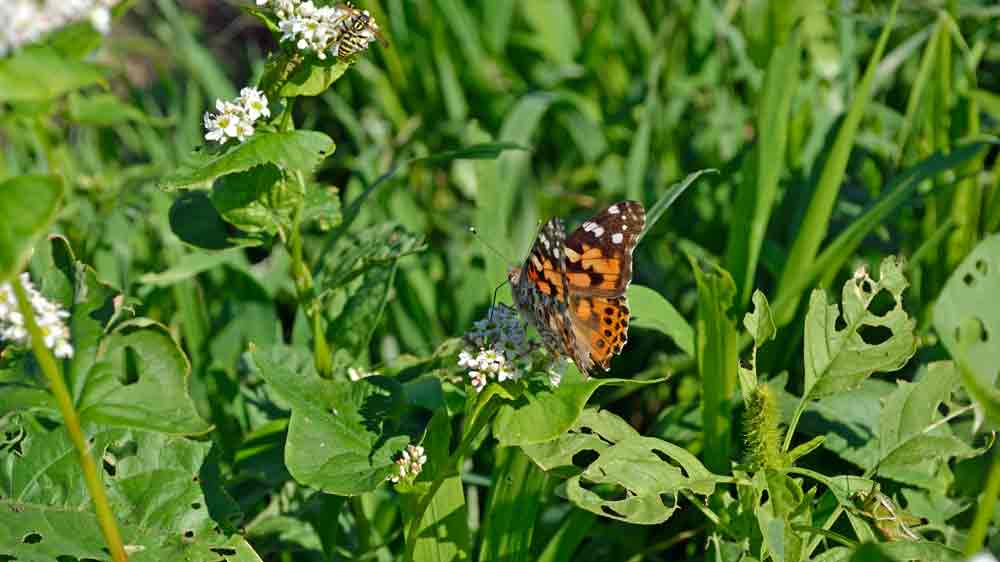
“Germination was excellent. I have a beautiful cover crop that the bees are totally enjoying. This mix has been the easiest cover crop I have ever planted, no fuss, very little upkeep, just add a little moisture. It’s so magnificent I spend 5-10 minutes every day just enjoying it.”
– Linda
“I’ve grown vegetables in my 4 4’x12′ raised beds for over 25 year, renewing the soil annually with a layer of compost; yields had become just OK. Two autumns ago I planted the Cover Up Mix, turned it into the soil in spring, covered the beds with the usual compost; happily report last year’s yields were up appreciably. The garden was positively lush (an unusual state in our high desert environment with 2017’s prolonged high summer heat). So I planted your cover crop mix again last fall and am looking forward to this year’s results. Definitely recommend!”
– Kerry
“First time I’ve used a cover crop; planted 6 weeks ago in 1/2 of my garden because the other half was still producing. Easy to plant, grew quickly with great coverage. The best part is that everywhere the cover crop was planted there are NO WEEDS! Morning glory has been my biggest problem and I have none where I planted the cover crop. Seeing the comparison between the two halves has made me a believer… already re-ordered enough for the whole garden for next year, and plan on using it in my flower beds, too. Highly recommend!”
– Pamela
Soil Builder Mix
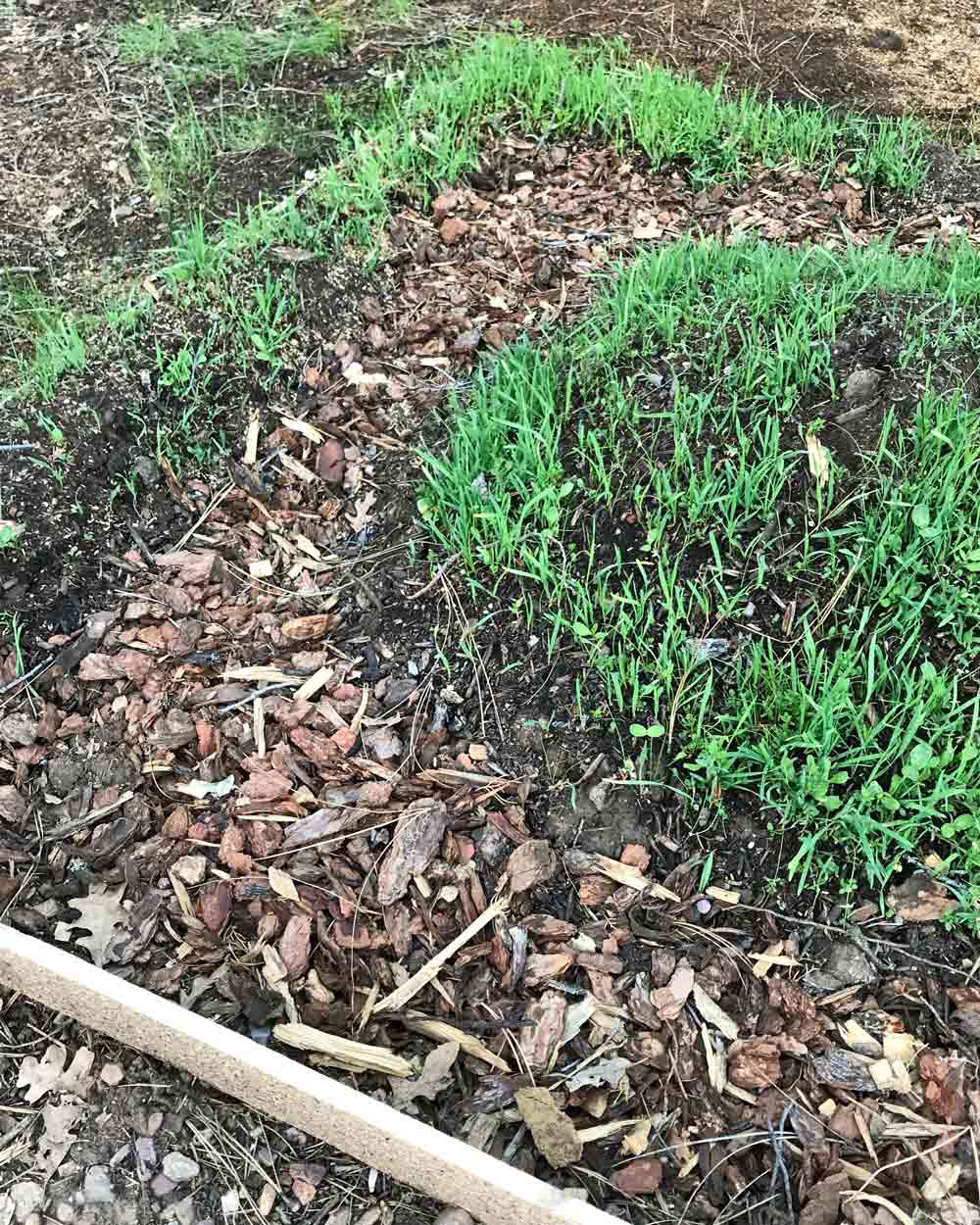
“Great germination, fast early growth and very thick. Really looking forward to better soil.”
– Victoria
“I love this! It is growing so healthy and lush. I love the great variety of plants in it. It will get turned in as a green manure day after tomorrow and I am so looking forward to reaping the benefits!”
– Donna
How and Why Cover Crops Work

Suppress Weeds
The best way to suppress weeds is with a highly competitive crop that quickly forms a canopy and shades weeds out. Summer annual cover crops like buckwheat and crimson clover form tight, dense canopies and will often outgrow many weeds. A diverse mixture of cover crops like our Garden Cover Up Mix – which includes both buckwheat and crimson clover – is much more weed-competitive than a single species.
Reduce Weeds in Next Year’s Garden
Planted in late summer or early fall as part of our Garden Cover Up mix, cereal rye is one of the best weed-suppressing tools if your next crop in that bed will be a legume like beans, chickpeas, lentils, peas, or soybeans as it aggressively ties up nitrogen – leaving little for weeds to use.
The legumes don’t mind, as they just fix their own nitrogen.
If your next crop is nitrogen demanding like corn or green leafy vegetables, a fall legume like hairy vetch can be used to both produce nitrogen and suppress weeds. Vetch does make nitrogen, but when it is cut or frost-killed the nitrogen is a protein and must decompose before it is available to either crop or weeds.
Both rye and hairy vetch form a thick mulch when cut that helps suppress small-seeded weeds like Palmer amaranth – better known as pigweed – by starving them of sunlight after germination so they run out of energy. Both rye and vetch produce biochemical compounds that stunt weed growth, called allelopathy.

Fix Nitrogen
This is best accomplished with a diverse mix dominated by legumes like our Garden Cover Up Mix. Remember, mixtures are capable of fixing much more nitrogen in a more stable and plant-useable form than single-species cover crops alone.

Build Soil Organic Matter
As gardeners, this should be our very first priority.
As we have learned more about how soil organic matter is formed, we have come to realize the most important contributor to soil organic matter happens in the root zone through what is known as root exudates – biologically active compounds deposited into the soil through the roots – and not simply the aboveground plant growth as previously thought.
Therefore, the best and fastest way to dramatically improve your soil health and fertility is through significantly increasing root growth of a diversity of species and plant families, along with as much aboveground biomass as possible.
Diversity of plant families makes for a more nutritious diet for the soil organisms that build organic matter in the soil, as some species have root exudates high in sugar, others high in protein, others high in lipids, while others are high in minerals; when combined, it makes a more complex and balanced diet than a single cover crop can provide. In general, since the production of root exudates depend on the level of photosynthesis, the more biomass a plant produces, the higher the root exudates and the faster you build soil organic matter.
To Really Build Soil Organic Matter
Inoculate your first planting with our mycorrhizal fungi – MycoGrow. Mycorrhizal fungi form mutually beneficial relationships with plant roots, extending their reach and monitoring nearby soil nutrients, feeding needed nutrients that are otherwise out of reach of the plant roots.
The soil proteins – called glomalin – produced by the mycorrhizal hyphae is the most persistent form of organic matter known and does wonders for the soil.
Now It’s Your Turn
Hopefully, you have a much better understanding of why and how cover crops can make a big positive difference in your garden, no matter if you have a traditional row garden, raised beds, or large containers. If you have soil, cover crops will improve it!
We’ve watched the skepticism on people’s faces when we talk about the multiple benefits of using cover crops in their garden, but then when they try them, the skeptical looks turn to astonishment when they describe how much better their gardens performed.
Help Us Help You
Did this help you understand cover crops better? Do you know a gardening friend who could use this information in their garden?
Please share this with your friends – either with the buttons below or on your social network of choice.
Soil Builder vs Garden Cover Up Mix – which is best for your garden?
Both of our cover crop mixes give you multiple benefits in the soil and above it. You can’t go wrong with either one. The Garden Cover Up mix is a general use cover crop, while the Soil Builder mix is more specific toward improving the overall condition of your soil.
Cover crops improve soil in a number of ways. They protect against erosion while increasing organic matter and catch nutrients before they can leach out of the soil. Legumes add nitrogen to the soil. Their roots help unlock nutrients, converting them to more available forms. Cover crops provide habitat or food source for important soil organisms, break up compacted soil layers, help dry out wet soils and maintain soil moisture in arid climates.
It’s always a good idea to maintain year-round soil cover whenever possible, and cover crops are the best way.
Let’s look at how cover crops work overall, then we’ll see the differences of each mix.
Most cover crop mixes are legumes and grains or grasses. Each one has a different benefit to the soil. Legumes include alfalfa, clover, peas, beans, lentils, soybeans and peanuts. Well-known grains are wheat, rye, barley and oats which are used as grasses for animal forage.
Legumes
Legumes help reduce or prevent erosion, produce biomass, suppress weeds and add organic matter to the soil. They also attract beneficial insects, but are most well-known for fixing nitrogen from the air into the soil in a plant-friendly form. They are generally lower in carbon and higher in nitrogen than grasses, so they break down faster releasing their nutrients sooner. Weed control may not last as long as an equivalent amount of grass residue. Legumes do not increase soil organic matter as much as grains or grasses. Their ground cover makes for good weed control, as well as benefiting other cover crops.
Grains or grasses
Grain or grass cover crops help retain nutrients–especially nitrogen–left over from a previous crop, reduce or prevent erosion and suppress weeds. They produce large amounts of mulch residue and add organic matter above and below the soil, reducing erosion and suppressing weeds. They are higher in carbon than legumes, breaking down slower resulting in longer-lasting mulch residue. This releases the nutrients over a longer time, complementing the faster-acting release of the legumes.
This pretty well describes what our Garden Cover Up mix does, as it is made up of 70% legumes and 30% grasses.
Our Soil Builder mix takes this approach a couple of steps further in the soil improvement direction with the addition of several varieties known for their benefits to the soil structure, micro-organisms or overall fertility.
For example, the mung bean is a legume used for nitrogen fixation and improving the mycorrhizal populations, which increase the amount of nutrients available to each plant through its roots.
Sunflowers are renowned for their prolific root systems and ability to soak up residual nutrients out of reach for other commonly used covers or crops. The bright colors attract pollinators and beneficials such as bees, damsel bugs, lacewings, hoverflies, minute pirate bugs, and non-stinging parasitic wasps.
Safflower has an exceptionally deep taproot reaching down 8-10 feet, breaking up hard pans, encouraging water and air movement into the soil and scavenging nutrients from depths unreachable to most crops. It does all of this while being resistant to all root lesion nematodes. Gardeners growing safflower usually see low pest pressure and an increase in beneficials such as spiders, ladybugs and lacewings.
Now you see why you can’t go wrong in choosing one of our cover crop mixes! Both greatly increase the health and fertility of the soil, along with above-ground improvements in a short time. Even if you only have a month, the Garden Cover Up mix will impress you for the next planting season.
For a general approach with soils that need a boost but are still producing well, the Garden Cover Up mix is the best choice. Our Soil Builder mix is for rejuvenating a dormant bed or giving some intensive care to a soil that has struggled lately. Both will give you a serious head start in establishing a new growing area, whether it is for trees, shrubs, flowers, herbs or vegetables.
Let one of our cover crops go to bat for you and see what happens when you play on Mother Nature’s team!
Can cover crops improve garden soil in one month?
Cover crops – also called green manures – have improved soil for thousands of years. 3,000 years ago Chinese agriculture began planting horsebeans and sesame for soil improvement. Much later the Greeks and Romans sowed special crops to increase soil fertility.
The past 60 – 80 years has seen an incredible amount of knowledge emerge from small farmers experimenting with planting different cover crops and learning from what resulted. This knowledge was built on a foundation of several hundred years of European trial and error.
We now have access to detailed information about how to use cover crops for the maximum benefits in our gardens, pastures and fields.
Our Garden Cover Up Mix was developed from research into the specific benefits we wanted to bring to the home garden soil, as well as what species supported each other.
This photo essay is a look at what one month – 4 weeks – of growth provides in an average raised bed.
After sowing we began watering with our drip system, but the monsoon rains provided a good amount of water over the month. This helped the plant growth along, so your results may be a week or two behind these photos.
Week One
At one week, the mix has almost all sprouted and shown vigorous growth. The oats and rye are shooting up, looking like grass while the buckwheat spreads its leaves and the clover hugs the soil. The peas were just beginning to show up, as they took a few days longer to absorb moisture and begin germinating.
We planted the different parts of the mix separately to get an idea of how they grew by themselves and with other species in support.
The rye and oats both shot up rapidly, germinating within 3 – 4 days and showing good soil coverage.
The crimson clover was also up fast, creating a fluffy green blanket over the soil with its tiny green leaves. Even with only an inch of growth it was easy to feel the temperature differences between the tops of the leaves and the soil temperature – it felt like 15°F difference!
The buckwheat was a couple of days slower coming up than the oats or rye. Once the sprouts appeared they immediately opened their leaves and really started growing.
Week Three
After three weeks the mix has almost completely covered the raised bed. The root system is about 3/4 of the top growth at this point, so the root density below the soil is almost as much as seen here. This is why cover crops are so beneficial to soil fertility.
A closer look shows how much shade the soil has and how thick the mix is growing. This out-competes most weeds above the soil while the roots choke out weeds below.
The young seedlings have just finished emitting auxins, a natural root hormone that inhibits other seeds from growing.
This mechanism gives the cover crops a head start over any other weeds for the next 2 – 3 weeks. When weed seeds can’t germinate, they will often rot as the soil fertility improves.
Week Four
The growth accelerated going into the fourth week, as these photos show. The white PVC stake is about 14 inches tall. Last week the growth was about 3 – 4 inches, but this week it shot up above the top of the stake.
Besides putting on a lot of height, the mix also completely filled in the raised bed. Weeds have no space to grow and we could only find one or two after searching for them.
The soil is much cooler than the surface of the leaves. It is also moister, but that could be due to the amount of recent rains and not the cover crop. The buckwheat is starting to bloom and is attracting bees as seen in the top photo detail.
The buckwheat is the tallest of the mix at about 21 inches tall. The mix is extremely full and thick up to about 16 inches, completely choking out any weeds. The root system is still about 3/4 of the height of the plants, so there is an amazing amount of roots below ground! This shows why planting cover crops does so much to improve the physical structure of the soil.
As the roots die and decay they add organic matter to the soil, open up moisture and air pathways where the roots grew and increase the carbon content – all at the same time!
Pretty good for a few minutes spent planting the seeds and a months’ worth of growth!
Both the rye and oats look like really lush grass. They completely cover the soil and top out at just over 15 inches at one month. We couldn’t find any weeds in this test plot.
Looking closer at the density of the rye planting, it is easy to see why weeds don’t stand a chance. There is no room for anything other than the rye with this dense seeding rate, which is the point.
Next Steps
If a killing frost happened tomorrow there is enough growth to create an excellent mulch while the root system will feed the soil and its microbial populations.
Our first frost is still several weeks off so the cover crops will keep growing both above and below the soil level. The flowers need watching to prevent setting seed and creating another crop next season. We will clip or mow the flower heads as they develop if there isn’t a frost soon enough.
If the rest of the mix can develop before mowing or a killing frost, it gives more nutrition and benefits to the garden bed.
Cover crops will increase the bio-available nutrition in your soil for next season, even if you use a well-aged compost. Both approaches have benefits but if used together support each other and create a better, more fertile soil sooner than if only one is used.
You don’t need a lot of time to grow a good cover crop and seriously improve your garden soil – a month will do! Even if you only have 2 – 3 weeks you will be better off with a shorter planting than none at all.
Go plant some cover crops. Your garden will reward you handsomely next season!
Cover Crops Q & A
Our cover crop mix has generated lots of questions on how to use it. This means we need to share more information with you. It is fantastic seeing so much interest about improving your soil and your garden!
I’ve taken the most frequent questions and condensed them into a Q&A format below.
“I want to order cover crop seed. I don’t know how much I need, how to prepare the garden before sowing the seeds and when to plant it.”
The Garden Cover Up mix page lists the coverage rates for each variety.
1 lb will seed 200 square feet, or a 10×20 garden bed or 2 5×10 beds. 8 oz will seed 100 square feet, or a 10×10 garden bed. This gives you a thick planting, boosting soil fertility and decreasing weed pressures.
Ideal planting times are early August through mid-September, depending on your growing season. Plant around mature garden vegetables or in spaces left from the removal of older plants.
Preparation is easy. Broadcast the seeds and rake them into the top half inch of moist soil, or cover with 1/2 inch of mulch or compost. Water equal to 1 inch of rainfall per week until seedlings become established.
The best time to plant is 6 – 8 weeks before your first frost date. If you don’t know your expected first frost date, use the First and Last Frost Dates tool from the National Garden Association.
Enter your ZIP code and find the weather station closest to you.
The first frost date is the intersection of the vertical 50% column and horizontal Fall 32°F line.
Count back 6 to 8 weeks to determine when you should sow the cover crop seed. By planting a few weeks early you’ll have bigger growth, but may need to clip the spent flowers to prevent re-seeding.
“Can/should cover crops be used in raised beds? Approx 3-4′ X 6-8′. Do they need to be turned in the spring? Do they go to seed and become intrusive?”
Cover crops are good for any sized garden larger than a container garden where it is easier to change the soil out. Your raised beds would benefit from our cover crop mix.
If you get a good freeze, the mix will “winterkill”, meaning they will die after a hard frost of around 24°F or so. Then the plant matter will fall down to become mulch for the soil, while the roots decompose. You can turn them under, but I don’t recommend it as tilling or turning disturbs the soil structure. You can plant right among the mulch in the spring.
The cover crops will set seed and scatter those seeds if you let them. Plant cover crops 6 – 8 weeks before the first frost so they get good growth and flower but usually don’t have the chance to set seed. If you see seed forming, just clip those seed heads off and throw them away.
This way the cover crop can’t be an unwanted guest next spring!
“I would like to start a cover crop on a small portion of my property and put in a garden next year. What do I have to do to prepare the soil to put in a cover crop. Also, when do I turn over the cover crop?”
You have a great thought in using the cover crops to help establish and improve the garden soil for next season.
This is the exact method used by organic farmers and growers to prepare fallow soil for a crop. Growers will plant cover crops in succession, or they allow the flowers to re-seed themselves.
Rake to loosen the top inch or so, broadcast the cover crop seed and rake again until just covered. Water the area equal to 1 inch of water per week until the seeds sprout and the plants establish themselves.
Let the plants flower and start setting seed, then clip the heads to prevent them from re-seeding. Allow the plant matter to die in the frost, creating its own mulch. The roots and topsoil mulch decompose over the winter, giving you with an excellent start to next gardening season!
“I am slowly working toward taking my area back from prairie dogs and building a garden plot on 4 acres that are usually dry and sandy. Do you have a general ground cover seed mix to assist in soil health and holding my sand back from flowing away during the monsoon season?
I keep chickens with portable netting so something edible for them would be good.”
Our Garden Cover Up Mix provides plenty of nutritious forage for your chickens. Plant a test plot close to where they are. Water the area equal to 1 inch of water per week until the seeds sprout and the plants establish themselves. Then you can trim some as fodder for the chickens as it grows and develops.
Our Backyard Chickens collection is another option. It has a variety of tasty edibles like sunflower, corn, Swiss chard, mustard and kale.
For erosion control, I would plant a straight (50/50) mix of buckwheat and cereal oats. Both are fast growing with good root systems that hold the soil in place. They provide good mulch after the plant dies off. You might test plant a strip about 3 – 5 feet deep crosswise to how the water flows during monsoon season. This acts as a catch strip, slowing the water down and reducing the amount of soil moved. It also creates a berm for future moisture retention. The roots create a “sink” for the water flow which diverts the water into the soil and away from flowing across it. This starts to build up the shallow soil and water reserves on your property.
I would not mow or kill this planting but allow it to re-seed and establish itself well. If the test works, you can replicate this downstream of where the water flows as many times as needed.
Once the initial berm starts to form, plant the Garden Cover Up mix up stream. This takes advantage of the extra moisture to reclaim and build some good soil!
This will only take 2 or 3 seasons to establish some excellent berms fully and then you can plant more.
“I have celiac disease and therefore cannot be around wheat, and am also sensitive to oats. Do you have any other recommendations?”
Buckwheat is not related to wheat at all, as it is in the Rhubarb family – if you can believe that! You should not have any reaction to buckwheat. You can avoid the oats by ordering the individual cover crop varieties. The Crimson clover and hairy vetch are strong nitrogen fixers, where the Buckwheat and Rye are fast growing ground covers.
You can make your own mix by ordering the smaller amounts of the individual cover crops, avoiding what you are sensitive to.
“After the cover crop dies or you kill it – should you till it into the ground?”
The cover crop mix will die after a couple of hard frosts. It becomes a mulch insulating and protecting the soil over the winter. During that time the roots decompose and increase the soil fertility. Depending on your climate over the winter the mulch should almost dissappear by next spring’s planting time.
I don’t recommend tilling a cover crop, it disturbs the soil you spent the winter improving. When planting, open a small space in the mulch. Then it continues covering and protecting the soil while smothering weeds.
If you do feel the need to till, raise the tines to only till the top 2 – 3 inches of soil and don’t disturb deeper layers. This will work the decomposed vegetative matter into the soil where it will be used quickly.
The process is to plant a fall cover crop, let it die and overwinter to improve the soil. Next spring, plant another after the garden crops are in and up. This covers the soil and shades out most weeds. Repeat this cycle yearly and the soil becomes incredibly fertile after a year or so.
In fertile soil weeds aren’t as much of a problem because they just don’t germinate as well. Fewer weeds leads to fewer insects, as many insects “partner” with specific weeds for habitat or to lay eggs on. Increased soil fertility means healthier plants which do not attract predatory insects.
“I planted clover one fall as a cover crop, and found that in spring it had formed such a dense mat of roots I had to use a pickax, and it never DID die back in winter! (Living in a warmer winter climate.)
I have clay in my soil and have been amending it for several years now. Wouldn’t tilling the soil deeply (about 12 inches) be beneficial for breaking it up and making it more accessible to my garden plants’ root systems? It’s really solid and unfriendly down there in the root zone!”
Thanks for your question! That’s why you need to kill the cover crops manually if the weather doesn’t freeze cold enough to kill them. Mowing or weed-whacking is the easiest way to do this. Otherwise, the plants don’t die, the roots don’t decompose and you struggle to plant your garden.
If you kill the cover crops from late October to mid-November, they will benefit the soil!
There are a couple of ways to open up the soil, especially with a clay component.
1 – You can deep till the soil. Realize you are destroying many micro-organisms as you are completely changing where they live. This is ok once or maybe twice when first establishing the garden, but is detrimental to the soil health if done often.
2 – Use a broadfork or other mechanical means to open up the soil without disturbing the layers. This is often done by hand, so will only work in a smaller garden. Because you won’t be able to drill down deep in a hard soil, this might need to be done a few times over a couple of seasons.
3 – Plant cover crops or aggressive root crops such as sunflower, wheat, sesame or Daikon radishes which drill down and open up the soil. This isn’t a one time, fix-all solution, but with replanting in spring and fall the cover crops can continue building and improving the soil.

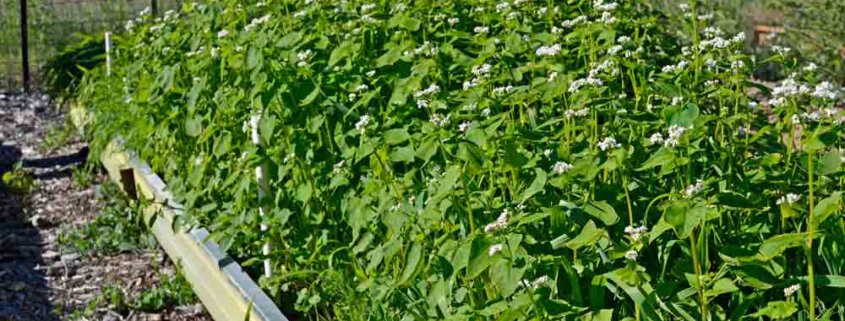 2019 Terroir Seeds
2019 Terroir Seeds